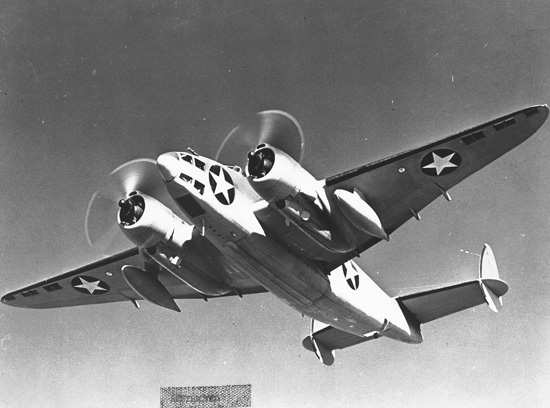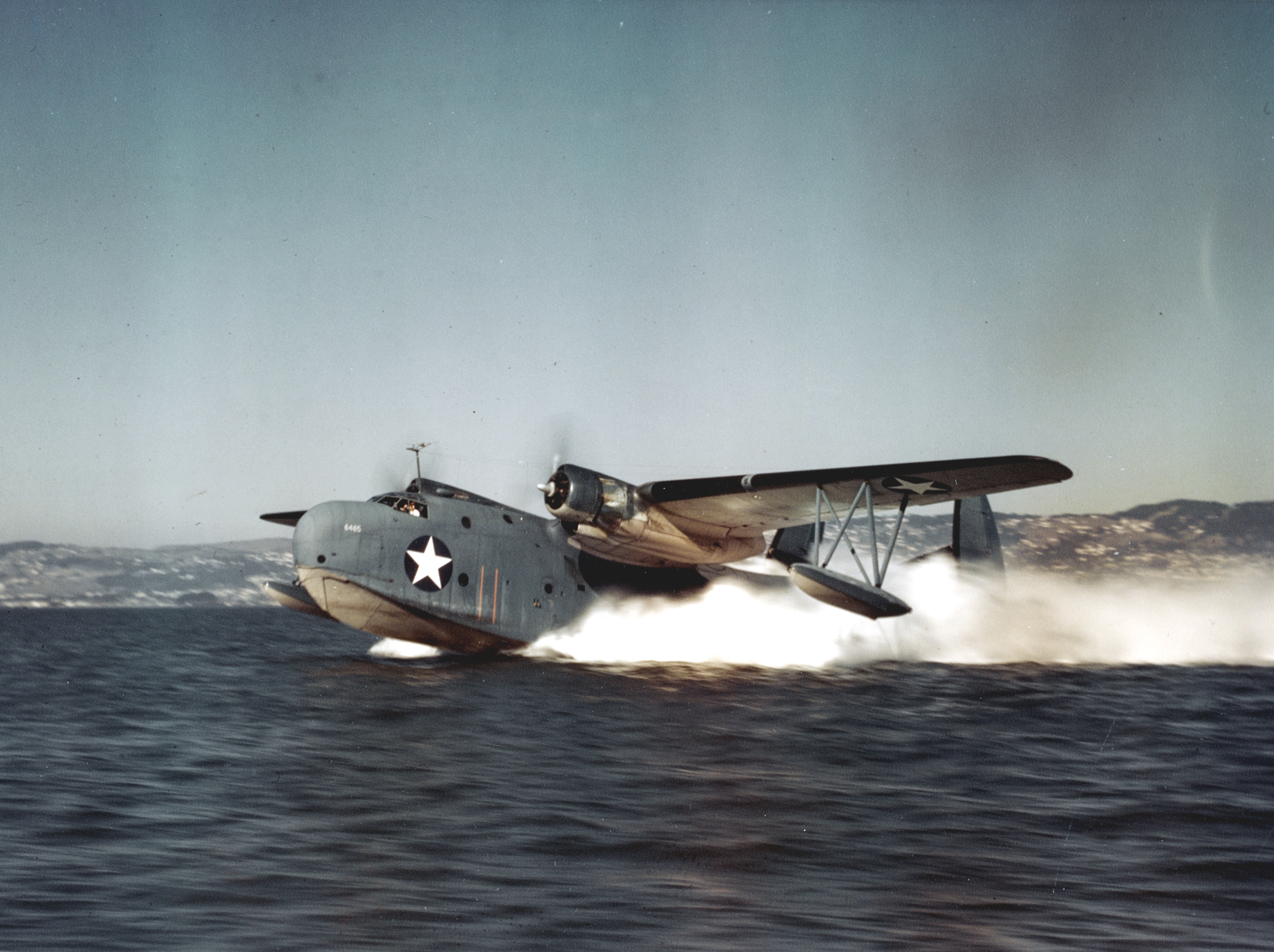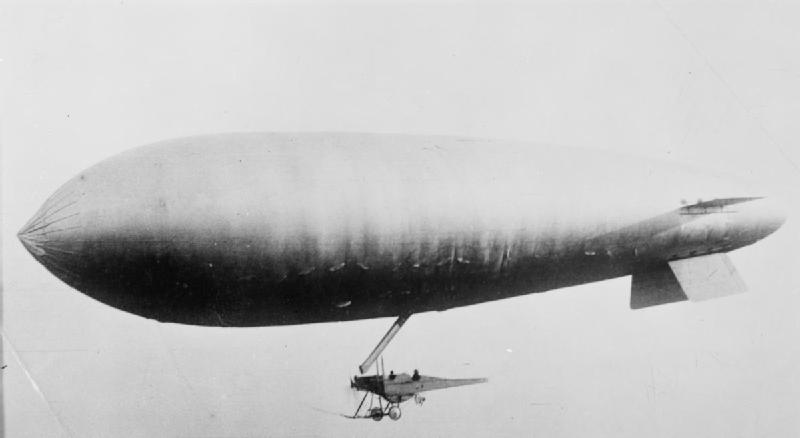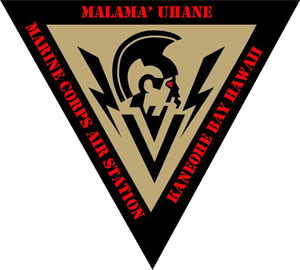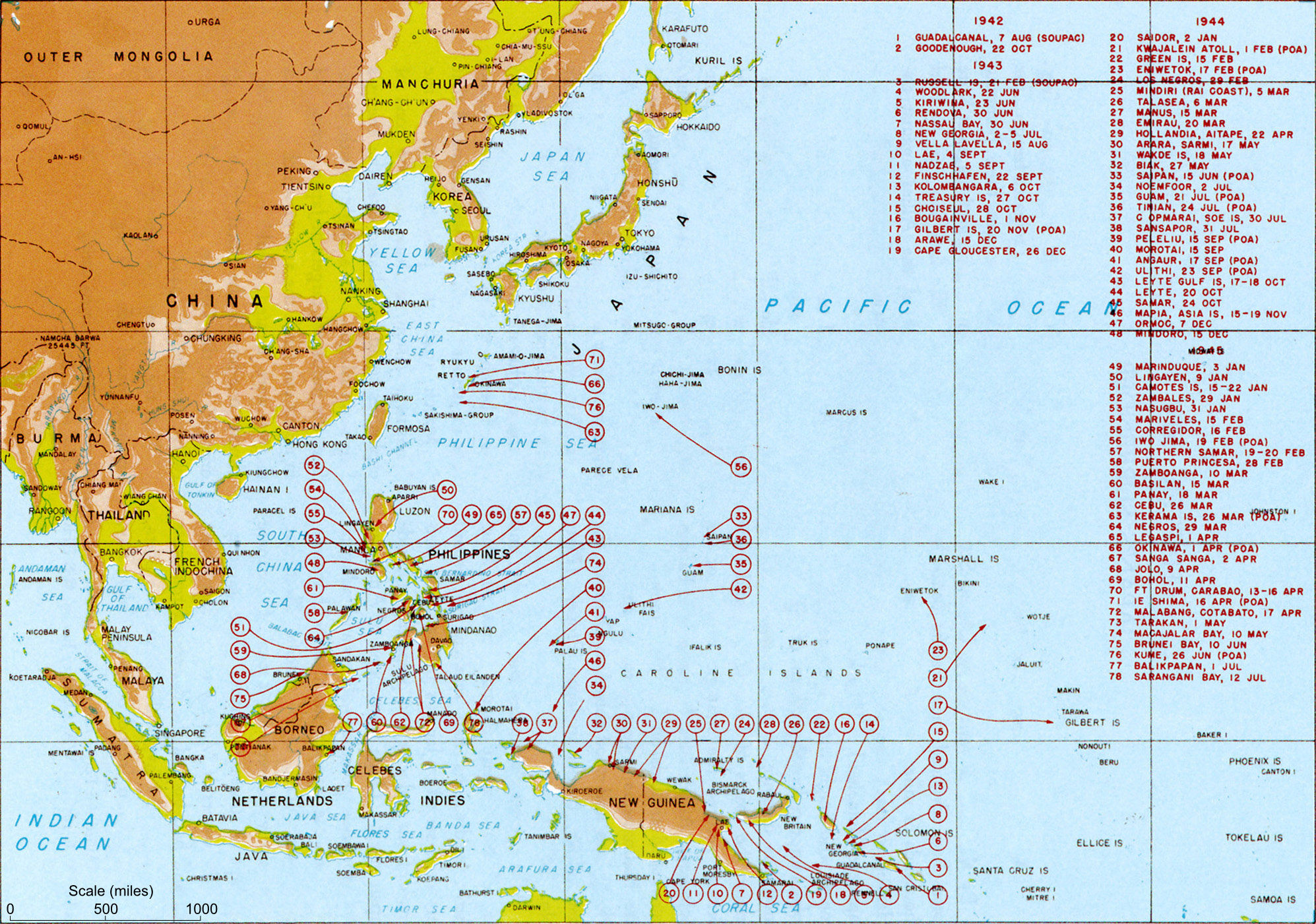|
VP-HL-5
VP-HL-5 was a Heavy Patrol Squadron (Landplane) of the U.S. Navy. The squadron was established as Bombing Squadron 143 (VB-143) on 15 June 1943, redesignated Patrol Bombing Squadron 143 (VPB-143) on 1 October 1944, redesignated Patrol Squadron 143 (VP-143) on 15 May 1946, redesignated Heavy Patrol Squadron (Landplane) 5 (VP-HL-5) on 15 November 1946 and disestablished on 27 May 1947. Operational history *15 Jun–26 Jul 1943: VB-143 was established at Naval Air Station DeLand, Florida, as a medium bombing squadron flying the PV-1 Ventura. While at DeLand, the squadron came under the operational control of FAW-12. On 26 July, the squadron was relocated to Naval Auxiliary Air Field Boca Chica, Florida, for operational, shakedown and ASW training. *16 August 1943: VB-143 was given orders to depart Boca Chica for duty at NAF Recife, Brazil, under the operational control of FAW-16. The squadron was fully operational within a month and was able to claim that throughout the duration ... [...More Info...] [...Related Items...] OR: [Wikipedia] [Google] [Baidu] |
List Of Inactive United States Navy Aircraft Squadrons
Most of the United States Navy aircraft Squadron (aviation), squadrons established since the Navy designated its first aircraft squadrons in 1919 no longer exist, having been "disestablished". Another 40 or so have been "deactivated", currently existing only "on paper" in an inactive status. These disestablished and/or deactivated squadrons are sometimes incorrectly referred to as decommissioned squadrons, but the U.S. Navy does not "commission" or "decommission" aircraft squadrons. Until 1998, squadrons were "established", "disestablished", and sometimes "re-designated"; since 1998, squadrons are "established", "deactivated", and sometimes "reactivated" and/or "redesignated". It has never been correct to refer to U.S. Navy aircraft squadrons as being commissioned and decommissioned, ships are commissioned and decommissioned, U.S. Navy aircraft squadrons are not. Under the system in use until 1998, a squadron's history and lineage began when it was established and ended when it w ... [...More Info...] [...Related Items...] OR: [Wikipedia] [Google] [Baidu] |
Lockheed Ventura
The Lockheed Ventura is a twin-engine medium bomber and patrol bomber of World War II. The Ventura first entered combat in Europe as a bomber with the RAF in late 1942. Designated PV-1 by the United States Navy (US Navy), it entered combat in 1943 in the Pacific. The bomber was also used by the United States Army Air Forces (USAAF), which designated it the Lockheed B-34 (''Lexington'') and B-37 as a trainer. Commonwealth of Nations, British Commonwealth forces also used it in several guises, including antishipping and antisubmarine search and attack. The Ventura was developed from the Lockheed Model 18 Lodestar transport, as a replacement for the Lockheed Hudson bombers then in service with the Royal Air Force. Used in daylight attacks against occupied Europe, they proved to have weaknesses and were removed from bomber duty and some used for patrols by Coastal Command. After USAAF monopolization of land-based bombers was removed, the US Navy ordered a revised design which ente ... [...More Info...] [...Related Items...] OR: [Wikipedia] [Google] [Baidu] |
United States Department Of The Navy Seal
United may refer to: Places * United, Pennsylvania, an unincorporated community * United, West Virginia, an unincorporated community Arts and entertainment Films * United (2003 film), ''United'' (2003 film), a Norwegian film * United (2011 film), ''United'' (2011 film), a BBC Two film * The United (film), ''The United'' (film), an unreleased Arabic-language film Literature * United! (novel), ''United!'' (novel), a 1973 children's novel by Michael Hardcastle Music * United (band), Japanese thrash metal band formed in 1981 Albums * United (Commodores album), ''United'' (Commodores album), 1986 * United (Dream Evil album), ''United'' (Dream Evil album), 2006 * United (Marvin Gaye and Tammi Terrell album), ''United'' (Marvin Gaye and Tammi Terrell album), 1967 * United (Marian Gold album), ''United'' (Marian Gold album), 1996 * United (Phoenix album), ''United'' (Phoenix album), 2000 * United (Woody Shaw album), ''United'' (Woody Shaw album), 1981 Songs * United (Judas Priest song ... [...More Info...] [...Related Items...] OR: [Wikipedia] [Google] [Baidu] |
Martin PBM Mariner
The Martin PBM Mariner is a twin-engine American Maritime patrol aircraft, patrol bomber flying boat of World War II and the early Cold War era. It was designed to complement the Consolidated PBY Catalina and Consolidated PB2Y Coronado, PB2Y Coronado in service. A total of 1,366 PBMs were built, with the first example flying on 18 February 1939, and the type entering service in September 1940, with the last of the type being retired in 1964. A Mariner, otherwise noted for its WW2 and post-War service, was the type that vanished searching for Flight 19. Flight 19 vanished in the Bermuda Triangle, it and the Mariner that searched for it were never found with its 14 crew, though it was thought to have suffered a mid-air explosion. Another noted crash was the 1946 Antarctica PBM Mariner crash in December 1946. Design and development In 1937 the Glenn L. Martin Company designed a new twin-engined flying boat, the Model 162, to succeed its earlier Consolidated P2Y, Martin P3M and c ... [...More Info...] [...Related Items...] OR: [Wikipedia] [Google] [Baidu] |
Maritime Patrol Aircraft
A maritime patrol aircraft (MPA), also known as a patrol aircraft, maritime reconnaissance aircraft, maritime surveillance aircraft, or by the older American term patrol bomber, is a fixed-wing aircraft designed to operate for long durations over water in maritime patrol roles — in particular anti-submarine warfare (ASW), anti-surface warfare, anti-ship warfare (AShW), and search and rescue (SAR). In addition to dedicated airframes, mid-size and large business jets have been modified for MPA missions, offering rapid deployment, extended range, long endurance, and lower life-cycle costs. Among other maritime surveillance resources, such as satellites, ships, unmanned aerial vehicles (UAVs) and helicopters, the MPA is an important asset. To perform ASW operations, MPAs typically carry air-deployable Sonobuoy, sonar buoys as well as torpedoes and are usually capable of extended flight at low altitudes. History First World War The first aircraft that would now be identified as ... [...More Info...] [...Related Items...] OR: [Wikipedia] [Google] [Baidu] |
Naval Air Station Kaneohe Bay
Marine Corps Air Station Kaneohe Bay or MCAS Kaneohe Bay is a United States Marine Corps (USMC) airfield located within the Marine Corps Base Hawaii complex, formerly known as Marine Corps Air Facility (MCAF) Kaneohe Bay or Naval Air Station (NAS) Kaneohe Bay. Most of the original contract work at Kaneohe had been completed when the Navy transferred what was undone to the Seabees of the 56th Naval Construction Battalion on 1 April 1943. The 112th CB was tasked with adding a second runway 400' x 5,000' to the airfield. That was completed by the men of the 74th CB. 7 December 1941, the Imperial Japanese Navy attacked the air station minutes prior to the attack on Pearl Harbor. Of the 36 Catalinas stationed here, 27 were destroyed and six others were damaged, along with 18 sailors who perished in the attack. The first Japanese aircraft destroyed in action were shot down at Kaneohe, along with Aviation Ordnanceman Chief Petty Officer John William Finn becoming one of the first M ... [...More Info...] [...Related Items...] OR: [Wikipedia] [Google] [Baidu] |
Naval Air Station Quonset Point
A navy, naval force, military maritime fleet, war navy, or maritime force is the branch of a nation's armed forces principally designated for naval and amphibious warfare; namely, lake-borne, riverine, littoral, or ocean-borne combat operations and related functions. It includes anything conducted by surface ships, amphibious ships, submarines, and seaborne aviation, as well as ancillary support, communications, training, and other fields. The strategic offensive role of a navy is projection of force into areas beyond a country's shores (for example, to protect sea-lanes, deter or confront piracy, ferry troops, or attack other navies, ports, or shore installations). The strategic defensive purpose of a navy is to frustrate seaborne projection-of-force by enemies. The strategic task of a navy also may incorporate nuclear deterrence by use of submarine-launched ballistic missiles. Naval operations can be broadly divided between riverine and littoral applications (brown-water na ... [...More Info...] [...Related Items...] OR: [Wikipedia] [Google] [Baidu] |
Surrender Of Japan
The surrender of the Empire of Japan in World War II was Hirohito surrender broadcast, announced by Emperor Hirohito on 15 August and formally Japanese Instrument of Surrender, signed on 2 September 1945, End of World War II in Asia, ending the war. By the end of July 1945, the Imperial Japanese Navy (IJN) was incapable of conducting major operations and an Operation Downfall, Allied invasion of Japan was imminent. Together with the United Kingdom and Republic of China (1912–49), China, the United States called for the unconditional surrender of Japan in the Potsdam Declaration on 26 July 1945—the alternative being "prompt and utter destruction". While publicly stating their intent to fight on to the bitter end, Japan's leaders (the Supreme War Council (Japan), Supreme Council for the Direction of the War, also known as the "Big Six") were privately making entreaties to the publicly neutral Soviet Union to mediate peace on terms more favorable to the Japanese. While mainta ... [...More Info...] [...Related Items...] OR: [Wikipedia] [Google] [Baidu] |
NAS Kaneohe Bay
Marine Corps Air Station Kaneohe Bay or MCAS Kaneohe Bay is a United States Marine Corps (USMC) airfield located within the Marine Corps Base Hawaii complex, formerly known as Marine Corps Air Facility (MCAF) Kaneohe Bay or Naval Air Station (NAS) Kaneohe Bay. Most of the original contract work at Kaneohe had been completed when the Navy transferred what was undone to the Seabees of the 56th Naval Construction Battalion on 1 April 1943. The 112th CB was tasked with adding a second runway 400' x 5,000' to the airfield. That was completed by the men of the 74th CB. 7 December 1941, the Imperial Japanese Navy attacked the air station minutes prior to the attack on Pearl Harbor. Of the 36 Catalinas stationed here, 27 were destroyed and six others were damaged, along with 18 sailors who perished in the attack. The first Japanese aircraft destroyed in action were shot down at Kaneohe, along with Aviation Ordnanceman Chief Petty Officer John William Finn becoming one of the first ... [...More Info...] [...Related Items...] OR: [Wikipedia] [Google] [Baidu] |
Camp Kearney
This is a list of North Atlantic Treaty Organization (NATO) installations in Afghanistan used during the War in Afghanistan from 2001 to 2021. This list encompasses installations used by the International Security Assistance Force from 2001 to 2014 and then by the Resolute Support Mission after 2014. Included are airbases, forward operating bases, main operating bases, combat outposts, firebases, and patrol bases used by NATO forces across the six regional commands (renamed Train Advise Assist Commands after 2014): Regional Command Capital, Regional Command East, Regional Command North, Regional Command South, Regional Command Southwest, and Regional Command West. History After 30 September 2013, there were only five sites used by the United Kingdom in Helmand Province including Camp Bastion (the main British base, closed 26 October 2014), MOB Price, MOB Lashkar Gah, PB Lashkar Gah Durai and OP Sterga 2 (last base outside Bastion, closed May 2014). After July 2021, all base ... [...More Info...] [...Related Items...] OR: [Wikipedia] [Google] [Baidu] |
NAS Quonset Point
Quonset Point Air National Guard Station is the home base of the Rhode Island Air National Guard 143rd Airlift Wing. Naval Air Station (NAS) Quonset Point was a United States Navy, United States Naval Base in Quonset Point, Rhode Island that was deactivated in 1974. Next to NAS Quonset Point was Camp Endicott at Davisville, home of the Naval Construction Battalions known as the Seabee (US Navy), Seabees. Quonset Point also gave its name to the Quonset hut, a standardized prefabricated building used by the U.S. military starting in World War II. Former US President Richard Nixon, Richard M. Nixon went through basic naval officer training at Quonset Point in 1942. History U.S. Navy use Commissioned on 12 July 1941, and encompassing what was once Camp Dyer, NAS Quonset Point was a major naval facility throughout World War II. Beginning in 1943, pilots of the Royal Navy's Fleet Air Arm were trained at Quonset Point to fly the Vought F4U Corsair, which was then brought into service o ... [...More Info...] [...Related Items...] OR: [Wikipedia] [Google] [Baidu] |
Floyd Bennett Field
Floyd Bennett Field is an airfield in the Marine Park, Brooklyn, Marine Park neighborhood of southeast Brooklyn in New York City, along the shore of Jamaica Bay. The airport originally hosted commercial and general aviation traffic before being used as a naval air station. Floyd Bennett Field is currently part of the Gateway National Recreation Area's Jamaica Bay Unit, and is managed by the National Park Service (NPS). While no longer used as an operational commercial, military, or general aviation airfield, a section is still used as a helicopter base by the New York City Police Department (NYPD), and one runway is reserved for hobbyists flying radio-controlled aircraft. Floyd Bennett Field was created by connecting Barren Island, Brooklyn, Barren Island and several smaller islands to the rest of Brooklyn by filling the Channel (geography), channels between them with sand pumped from the bottom of Jamaica Bay. The airport was named after Floyd Bennett, a noted aviator who pilo ... [...More Info...] [...Related Items...] OR: [Wikipedia] [Google] [Baidu] |

